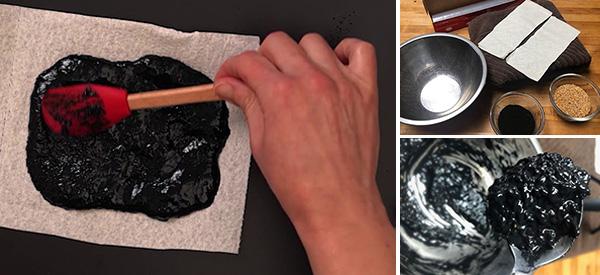
How to Make an Activated Charcoal Poultice
What is activated charcoal exactly? Charcoal is made out of carbon-rich material such as wood or coconut shells. The carbon-rich material is burned in a controlled environment at extremely high temperatures to produce the activated charcoal base. It’s then rinsed and ground into a fine powder and sold as the black chalky substance we are all familiar with. You can actually make it yourself. ⇒ See here how!
Activated charcoal uses range from detoxing to air and water purification. It’s universally known for its “drawing” potential, which can be done in many ways— internally and externally. For this article, though, the focus will be on using activated charcoal in poultice form, which is done externally.
Often poultices are made from plant material and used to draw out infections, and, at the same time, they can infuse the medicinal components of the plant back into the affected wound or skin. But when it comes to drawing out toxins, nothing beats the superiority of an activated charcoal poultice. It’s so powerful that it can even draw toxins out of internal organs merely by being applied topically.
Activated charcoal poultices are simple, easy, and they store incredibly well. Before we talk about how to make them, let’s look at some of their uses.
Activated Charcoal Poultice Uses
This poultice is anti-inflammatory and can reduce swelling, soreness, and pain. Knowing how to make your own activated charcoal poultice is a fantastic tool to have in your DIY health kit.
- Skin: You can use a poultice to assist with skin conditions such as boils, acne, abscesses, bug bites, bee stings, rashes, poison ivy, shingles.
- Eyes: Many have seen favorable results from using activated charcoal poultices on the eyes (lids closed, of course) for styes, pink eye, glaucoma, and “computer-screen eyes.” Supposedly you can see a visible change in the whites and brightness of the eyes after use.
- Organ Detox: One of the most profound activated charcoal benefits is its ability to draw toxins and inflammation from the inside out, from organs like kidneys, liver, or pancreas. Studies have even shown a great deal of success with using activated charcoal for kidney disease and liver disorders.
- Swelling and Inflammation: And try putting a poultice on your swollen lymph nodes the next time you are sick. It should help pull-out toxins and speed up recovery time. Lastly, you can apply your charcoal poultice to areas of your body afflicted by arthritis to reduce pain and inflammation.
Activated charcoal poultices are low risk and maybe even safer than ingesting activated charcoal. Some may experience digestive distress from internal use, and a poultice could be an excellent alternative for those individuals.
⇒ This is WHY You Should Have Charcoal Around Your Property
Directions
Your measurements will depend on what material you decide to use and how much you want to make. This recipe calls for flaxseed because flaxseed contains essential fatty acids that nourish the skin. The below formula made one 8 x 4-inch strip. Of course, you can add more or less, but it’s a good amount to start.
You can also make up a few activated charcoal poultices and store them in the refrigerator for a week or two and in the freezer for up to three months.
You Will Need
- 1 tablespoon of activated charcoal powder

- 1tablespoon of flaxseed, corn starch, chia seeds, psyllium husk, or arrowroot powder.
- 1tablespoon of hot water
- A dark towel
- A mixing bowl
- Plastic wrap
- 2—8 x 4-inch strips of thin material. You will spread your poultice onto this. Pictured is a thin cloth material that still allows the beneficial components of the charcoal and flax mixture to soak through but without the mess. You can also use gauze, cheesecloth, pantyhose, coffee filters, tea bags, pantyhose, or other thin material.
Instructions
- Lay your towel out where you plan on working before you even touch your activated charcoal. This velvety black powder will have your work area looking like a coal mine fast, and for some reason, it seems to always waft into your mouth. If you find yourself chewing a bit of grit, no worries, it happens to the best of us. In other words, it’s very messy, so be extra careful when handling it.

- Add your activated charcoal powder, flaxseed, and hot water to your mixing bowl and stir well. Let it sit for five minutes. The flaxseed will gel and thicken the mixture. You want it to scrape away from the bowl but not be too dry. If it’s dry, add a bit of hot water and if it’s too wet, add more flax and charcoal. You can also add a bit of starch if you have trouble getting the right consistency.

- Apply the gelled mixture to your selected material and spread it around, leaving just a bit at the edge. It should be about a quarter-inch thick.

- Place the other piece of material on top like a sandwich.

- Place your poultice flat on the desired area of the body. If it’s on a limb or your torso, wrap it with plastic wrap. This keeps it secure, clean, and moist. You can also add tape or a tight-fitting bandage on top of that to keep it in place if it doesn’t feel stable enough. Often clothing will also help keep your poultice secure, and you want to be comfortable enough to keep it on for the desired amount of time.

FAQ
Q: How long should you leave your poultice on?
A: An activated charcoal poultice can be safely left on the skin from 3 hours to overnight. In most cases, the poultice can do its job in a few hours, but if you are using it to bring a boil or abscess to the surface, overnight treatments may be the ticket. Likewise, detoxifying internal organs can take a bit longer as well.
Q: Are activated charcoal poultices okay for open wounds?
A: Yes, they can be very effective for drawing out infection and inflammation from open wounds. However, open wounds can grow bacteria and your poultice is moist. You can change out your poultice every couple of hours to avoid aiding unhealthy bacteria if you plan on leaving it on that long.
Q: How often can you re-apply the poultice?
A: If you had the poultice on for 8 hours, let your skin rest for 8 hours. Use however long you had the poultice on to determine how long you wait for another application.
Q: Are activated charcoal poultices safe for children?
A: Yes.
You may also like:
 DIY Skin Soothing Chickweed and Vinegar Bath for Rashes
DIY Skin Soothing Chickweed and Vinegar Bath for Rashes
How to Make 6 Pounds of Charcoal the Old-Fashioned Way (Video)
3 Home Remedies for Skin Fungus That Actually Work
Backyard Plants You Can Use For Skin Rashes
How to Make Black Drawing Salve for Boils, Wounds and Tick Bites

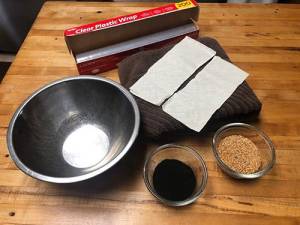
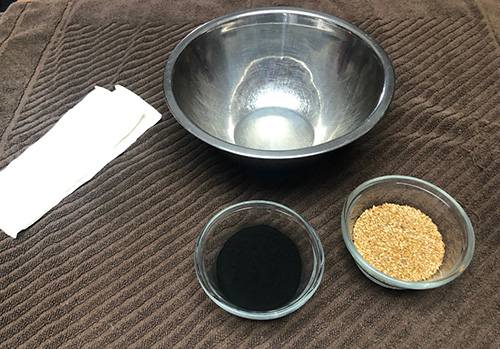
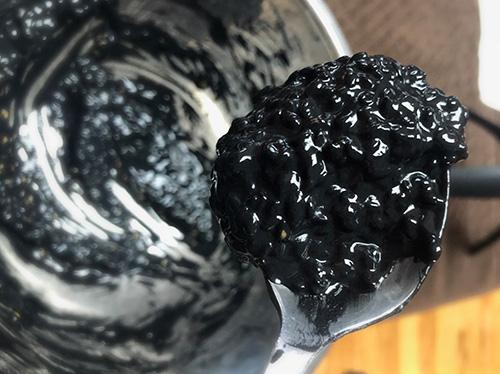
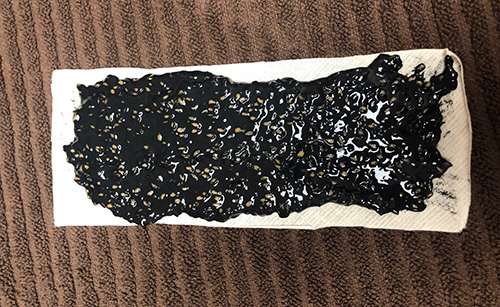
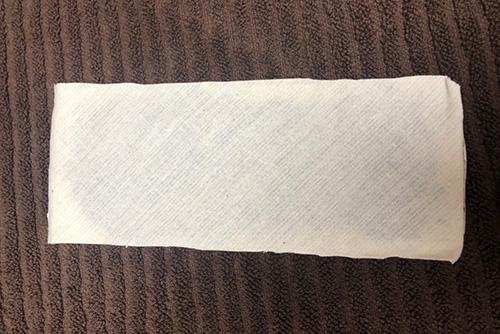
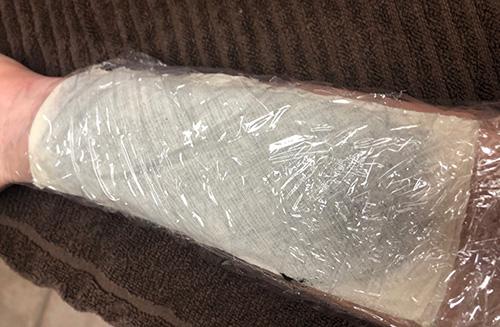
Can this poultice be used & effective on the chest/lungs for a cough/cold to draw out flem?
Please show us how to help detox organs, mainly the gut. Is it poltices, or salves? Also is how to take internally (and how to make it) for gut, liver, and kidney. Thanks so much
Go to charcoalremedies .com and he has a book on how successful he’s been with charcoal
Use Castor oil packs around the gut area for detoxing. There are many explanations and how to’s online. Just do a web search to find out how. You will need organic, hexane free castor oil, a cloth to put it on sized large for the gut area ( or buy a castor oil ‘belt’ ) and plastic to wrap so you don’t get it on clothing, a heating pad. Doing them for three days in a row is recommended. Begin with about 15-30 minutes. You may get headaches from toxins being removed, you can drink activated charcoal to reduce this effect (use a straw!)
How often should one do this poultice please.
How many times can you use the same poultice?
Each poultice is only good for one use. They dry up over time. I hope that helps. 🙂
Can we use the charcoal briquettes used for BBQ’s? If so, do we have to do anything to the briquettes before grinding into a powder?
Also, I do not have psyllium husks nor arrowroot, any substitutions. I want to make for my moms arthritis inflammation. Thank you.
No. Charcoal briquettes are toxic and should never be used for this purpose. However, activated charcoal is pretty inexpensive and can be obtained easily online or from your local health food store. And you can simply use corn starch or flax seed as a thickener.
Best of luck!
No. You cannot use briquettes. They contain fossil fuels
Thank you. I Just ordered some activated charcoal products from http://www.schizandu.com. Will get flax & psyllium from health food store. Was reading on difference using flax & psyllium. and between making a poultice and paste. 🙏🏻💕
HOW DID IT WORK… END RESULTS…?
Going to try
Do the flax seeds need to be ground or whole?
Hi Penny,
Thank you for your comment.
In this recipe, ground flax seed is used.
Many blessings and good health!
What is the purpose of the flax seed?
Hi Carol,
This recipe calls for flaxseed because flaxseed contains essential fatty acids that nourish the skin. The flaxseed will also gel and thicken the mixture.
Many blessings and good health!
Does it come on a Book Form
Can you use castor oil in place of water in the charcoal poultice? If so, does it add to the effectiveness?
I am wanting to know the same.